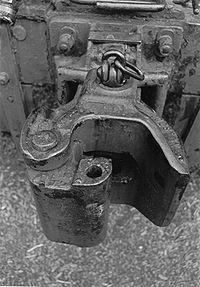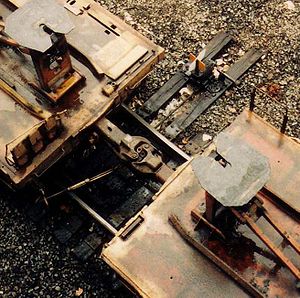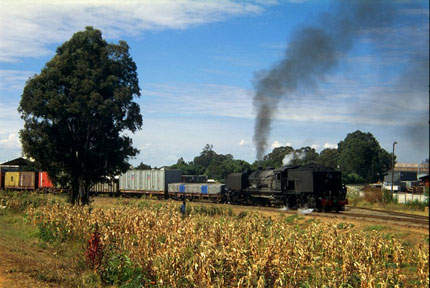Almost Leaving The Rails……
October 13, 2009
Still early 1974……….Mpompoma repair siding, just outside Bulawayo.
Having got my revenge on the tosser Journeyman (the one who locked me in a fuel wagon) by setting fire to a piece of oily rag hanging out of his back pocket with a cutting torch, successfully slow-burning a smouldering hole through his overalls, knickers (he was probably a cross-dresser) and backside, it was again time to move to another assignment.
This time I was sent out to a place called Mpompoma (also known as PomPom). It was quite far from the Mechanical Workshops and we went there in a big grey Rhodesia Railway lorry into which I loaded all my kit. I felt very important in this lorry, leaning out the window in my grubby overalls and whistling at the chicks as we belched vile smelling black diesel exhaust smoke on our way out of the city. I was even set loose on these missions without a Journeyman, although to be honest after the first year I worked just about full-time on my own.
Mpompoma was some kind of railway repair siding and I never could quite work out what the purpose was of fixing wagons there and not in the main workshops. For an apprentice plater-welder this was also a bit of a dodgy place for a number of reasons. Firstly my main task seemed to revolve around always being out in the blazing Rhodesian sun in full welding gear, and fixing something that someone else had managed to fuck-up through severe and probably malicious negligence.
There is a part of all wagon construction known as the coupling channel. For the uninitiated, the coupling is that hook like contraption at each end of a wagon or locomotive that hooks into the coupling at the end of another wagon or locomotive when they are shunted together. The wagons are then coupled or “hooked” together automatically and will happily follow each other around the tracks for as long as there is something pulling them. Unfortunately couplings probably take more abuse from locomotive drivers and shunters than any other part of a train.

A typical coupling
As you can see from the above photo these couplings are robust bits of kit and they have to be. They are also very long and stretch back into a closed cavity under the wagon known as the coupling channel. There is also the mother of all springs inside the cavity to cushion the effects of the old in and out motion. The next picture shows how the coupling moves into the coupling channel. Note that the square metal section behind the coupling moves in and out of the coupling channel and the mother of all springs dampens this movement.

Coupling channel
The problem with this rather clever design is that when any overadventurous locomotive driver or shunter couples to fast (known as a rough-shunt), the whole coupling assembly can become quite pissed-off and deform inside the coupling channel and get stuck. It then becomes a steel projectile under high tension, held back by the mother of all springs with nowhere to go. It just begs someone to climb under the wagon and release the pent-up tension. This is where my job came in and was dodgy work for a number of reasons. Firstly these wagons were on a perfectly serviceable stretch of railway line that was quite clearly in use. There was more than one occasion where I had to rapidly extricate myself from under a wagon, banging my head in the process because something big and black was moving up the line I was working on. I always made sure I was on good terms with my trolley boy on these jobs and I had to trust him to (a) stay awake and keep a sharp look-out, and (b) warn me if something was on my work line and moving towards me. He could get rid of me easily if he had a mind to.
Secondly the main mission under the wagon was to release the spring tension first, and this was done by cutting the spring itself with a cutting torch, which showered you with hundreds of bits of red-hot molten metal and sparks as usual. This was due to the contorted positions you had to get into normally face-upwards, making your nose and mouth great targets.
There was always a terrific bang when the spring was finally cut….undescribable unless you have experienced it and pretty scary. This was normally also accompanied by an extra shower of rust, encrusted dirt, and whatever animal parts might have become lodged in the coupling channel…..oh yes, they were everywhere.
Any attempt to remove the coupling before carrying out the above operation could possibly result in a very pissed-off and seemingly ballistically charged coupling ejecting the channel and comprehensively impaling you and your Jack the Ripper apron to any adjacent wagon.
Needless to say we tried to avoid this scenario as far as possible to dodge lengthy Health and Safety accident investigations, and the loss of any no-claim bonus you might enjoy on your life insurance.

Mpopoma Siding
After these trips we always got back to the Mechanical Workshops after dark. Only the overtime crews working. The days out at PomPom were long, hot, and tiring. I would clean and lock up my kit and begin the long, slow walk back to an empty room. The canteen was already closed for the night, there wasnt even that to look forward to……just the next day of the same thing.
Excellent read…as for ‘PomPom’…I would have left and joined the Sappers!
Fans are waiting for the next Instalment….!